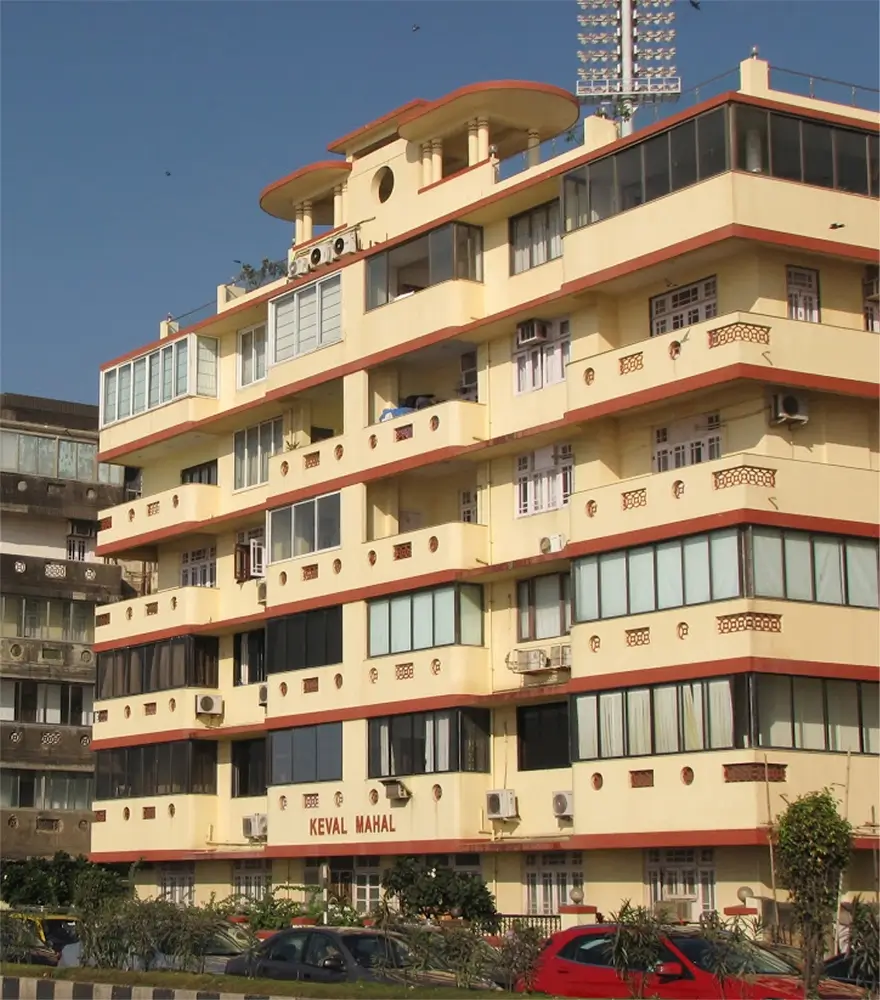Kewal Mahal
Glamour, Secrets, and the Espionage Beneath
A covert hub for British military intelligence during World War II.
Intended as luxury apartments for Bombay’s elite, they attracted wealthy Hindu families displaced during Partition and even Kuwaiti royals who used them as holiday homes Military Takeover: During WWII, Kewal Mahal was requisitioned by the British Military Intelligence (1935–1945) to serve as a secret service war office Censorship Hub:
Lieutenant Colonel CW Robinson oversaw the censorship of all incoming/outgoing mail in Bombay here, intercepting letters for sensitive information. Families like the Lentins lived alongside military activity. Dhun Lentin recalls buildings like Sea Green Hotel buzzing with soldiers.
“Wait, spies lived here?” is not the reaction you expect when walking past a pastel Art Deco building on Marine Drive, but that’s exactly what Kewal Mahal demands.
Sandwiched between its equally glamorous siblings, Zaver Mahal and Kapur Mahal, Kewal Mahal was built just before World War II by industrialist Nemchand K. Mehta for his three sons.
The buildings that line Marine Drive, bask in the sea breeze, their pastel façades glow at golden hour.
They look like they’ve witnessed glamorous parties, moody monsoon evenings, maybe even the occasional heartbreak set to a jazz record. But one of them has seen somethings entirely different.
British military intelligence kind of things.
Designed by PC Dastoor with geometric balconies and concrete jaali filigree, Kewal Mahal was meant for Bombay’s crème de la crème, until the war broke out. Practically overnight, the British intelligence commandeered it, swapping cocktail parties for typewriters and top-secret files.
Lieutenant Colonel C.W. Robinson set up a covert war office, running a massive censorship operation that screened every single letter entering or leaving Bombay.
But it wasn’t just about snooping on mail. Kewal Mahal became a critical node in British intelligence, monitoring Japanese movements in Southeast Asia and sniffing out threats to Bombay, which was constantly on edge due to its strategic port. Locals even had a name for the fear: topmaro no dar—the anxiety of being bombed.
And yet, civilian life continued just outside its walls. The Lentins, for instance, moved into Kewal Mahal on September 1, 1939, the exact day World War II began. While they unpacked their boxes, soldiers were being stationed next door. Hotels like the Sea Green were buzzing with military personnel, but the neighbourhood still held on to some strange version of “normal.”
Evenings might still mean a stroll along the Queen’s Necklace, the iconic curve of Marine Drive named for the way its streetlights glitter like pearls after sunset.
Interestingly enough, while Kewal Mahal was busy silencing dissent, Zaver Mahal, literally next door was broadcasting it. From within those Deco walls, teenage freedom fighter Usha Mehta ran an underground HAM radio station known as Congress Radio. Her midnight messages “This is a Congress Radio call to freedom!” mocked the very censorship Kewal Mahal was enforcing.
The Mehta family’s legacy goes beyond just business and war-time secrets. These three buildings weren’t just homes, they were hubs of Bombay’s film and social scene. Zaver Mahal, in particular, became a space frequented by prominent figures like actor-producer AR Kardar, singer SD Burman, and even the famous composer Madan Mohan, who hid out in Keval Mahal for his clandestine musical soirées.
The Mehtas also infused their buildings with a sense of hospitality that was reflected in their lavish lifestyle. They welcomed tenants with glamorous amenities and cinematic flair, at one point even advertising apartments at Roxy Cinema through slides. Yet, behind the scenes, they faced the reality of wartime anxiety. Despite the luxury, the Mehtas had to contend with the chilling presence of wartime fear. Their buildings stood in stark contrast to the storm brewing on the horizon, symbolizing the resilience of Bombay’s elite against a backdrop of growing global uncertainty.
Kewal Mahal is one of those buildings that reminds you just how much history is hiding in plain sight. Behind the soft colours and sleek curves are stories of secrecy, resistance, and a city that found ways to carry on.





